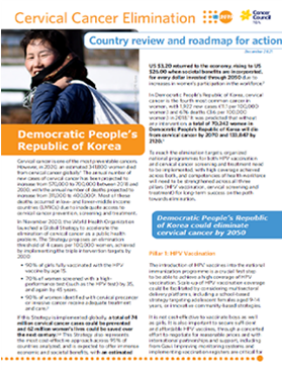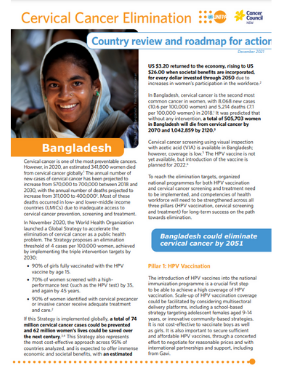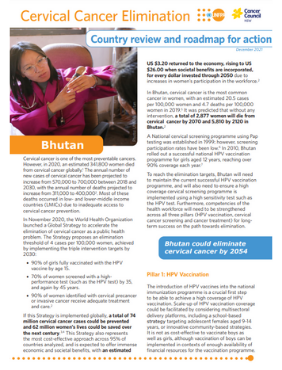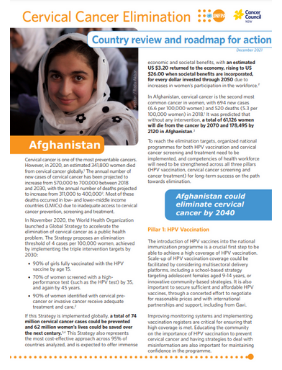You are here
New Releases

Laos: Cervical Cancer Elimination - Country Review & Roadmap for Action
Cervical cancer is one of the most preventable cancers. However, in 2020, an estimated 341,800 women died from cervical cancer globally. The annual number of new cases of cervical cancer has been projected to increase from 570,000 to 700,000 between 2018 and 2030, with the annual number of deaths projected to increase from 311,000 to 400,0002. Most of these deaths occurred in low- and lower-middle income countries (LMICs) due to inadequate access to cervical cancer prevention, screening and treatment.
In November 2020, the World Health Organization launched a Global Strategy to accelerate the elimination of cervical cancer as a public health problem. If this Strategy is implemented globally, a total of 74 million cervical cancer cases could be prevented and 62 million women’s lives could be saved over the next century.
The UNFPA Asia-Pacific Regional Office together with the Cancer Counsil NSW developed a series of briefs on Cervical Cancer Elimination to guide countries within the region. This is the country review and roadmap for action for Laos.

Indonesia: Cervical Cancer Elimination - Country Review & Roadmap for Action
Cervical cancer is one of the most preventable cancers. However, in 2020, an estimated 341,800 women died from cervical cancer globally. The annual number of new cases of cervical cancer has been projected to increase from 570,000 to 700,000 between 2018 and 2030, with the annual number of deaths projected to increase from 311,000 to 400,0002. Most of these deaths occurred in low- and lower-middle income countries (LMICs) due to inadequate access to cervical cancer prevention, screening and treatment.
In November 2020, the World Health Organization launched a Global Strategy to accelerate the elimination of cervical cancer as a public health problem. If this Strategy is implemented globally, a total of 74 million cervical cancer cases could be prevented and 62 million women’s lives could be saved over the next century.
The UNFPA Asia-Pacific Regional Office together with the Cancer Counsil NSW developed a series of briefs on Cervical Cancer Elimination to guide countries within the region. This is the country review and roadmap for action for Indonesia.

India: Cervical Cancer Elimination - Country Review & Roadmap for Action
Cervical cancer is one of the most preventable cancers. However, in 2020, an estimated 341,800 women died from cervical cancer globally. The annual number of new cases of cervical cancer has been projected to increase from 570,000 to 700,000 between 2018 and 2030, with the annual number of deaths projected to increase from 311,000 to 400,0002. Most of these deaths occurred in low- and lower-middle income countries (LMICs) due to inadequate access to cervical cancer prevention, screening and treatment.
In November 2020, the World Health Organization launched a Global Strategy to accelerate the elimination of cervical cancer as a public health problem. If this Strategy is implemented globally, a total of 74 million cervical cancer cases could be prevented and 62 million women’s lives could be saved over the next century.
The UNFPA Asia-Pacific Regional Office together with the Cancer Counsil NSW developed a series of briefs on Cervical Cancer Elimination to guide countries within the region. This is the country review and roadmap for action for India.

Democratic People's Republic of Korea: Cervical Cancer Elimination - Country Review & Roadmap for Action
Cervical cancer is one of the most preventable cancers. However, in 2020, an estimated 341,800 women died from cervical cancer globally. The annual number of new cases of cervical cancer has been projected to increase from 570,000 to 700,000 between 2018 and 2030, with the annual number of deaths projected to increase from 311,000 to 400,0002. Most of these deaths occurred in low- and lower-middle income countries (LMICs) due to inadequate access to cervical cancer prevention, screening and treatment.
In November 2020, the World Health Organization launched a Global Strategy to accelerate the elimination of cervical cancer as a public health problem. If this Strategy is implemented globally, a total of 74 million cervical cancer cases could be prevented and 62 million women’s lives could be saved over the next century.
The UNFPA Asia-Pacific Regional Office together with the Cancer Counsil NSW developed a series of briefs on Cervical Cancer Elimination to guide countries within the region. This is the country review and roadmap for action for the Democratic People's Republic of Korea.

Cambodia: Cervical Cancer Elimination - Country Review & Roadmap for Action
Cervical cancer is one of the most preventable cancers. However, in 2020, an estimated 341,800 women died from cervical cancer globally. The annual number of new cases of cervical cancer has been projected to increase from 570,000 to 700,000 between 2018 and 2030, with the annual number of deaths projected to increase from 311,000 to 400,0002. Most of these deaths occurred in low- and lower-middle income countries (LMICs) due to inadequate access to cervical cancer prevention, screening and treatment.
In November 2020, the World Health Organization launched a Global Strategy to accelerate the elimination of cervical cancer as a public health problem. If this Strategy is implemented globally, a total of 74 million cervical cancer cases could be prevented and 62 million women’s lives could be saved over the next century.
The UNFPA Asia-Pacific Regional Office together with the Cancer Counsil NSW developed a series of briefs on Cervical Cancer Elimination to guide countries within the region. This is the country review and roadmap for action for Cambodia.

Bangladesh: Cervical Cancer Elimination - Country Review & Roadmap for Action
Cervical cancer is one of the most preventable cancers. However, in 2020, an estimated 341,800 women died from cervical cancer globally. The annual number of new cases of cervical cancer has been projected to increase from 570,000 to 700,000 between 2018 and 2030, with the annual number of deaths projected to increase from 311,000 to 400,0002. Most of these deaths occurred in low- and lower-middle income countries (LMICs) due to inadequate access to cervical cancer prevention, screening and treatment.
In November 2020, the World Health Organization launched a Global Strategy to accelerate the elimination of cervical cancer as a public health problem. If this Strategy is implemented globally, a total of 74 million cervical cancer cases could be prevented and 62 million women’s lives could be saved over the next century.
The UNFPA Asia-Pacific Regional Office together with the Cancer Counsil NSW developed a series of briefs on Cervical Cancer Elimination to guide countries within the region. This is the country review and roadmap for action for Bangladesh.

Bhutan: Cervical Cancer Elimination - Country Review & Roadmap for Action
Cervical cancer is one of the most preventable cancers. However, in 2020, an estimated 341,800 women died from cervical cancer globally. The annual number of new cases of cervical cancer has been projected to increase from 570,000 to 700,000 between 2018 and 2030, with the annual number of deaths projected to increase from 311,000 to 400,0002. Most of these deaths occurred in low- and lower-middle income countries (LMICs) due to inadequate access to cervical cancer prevention, screening and treatment.
In November 2020, the World Health Organization launched a Global Strategy to accelerate the elimination of cervical cancer as a public health problem. If this Strategy is implemented globally, a total of 74 million cervical cancer cases could be prevented and 62 million women’s lives could be saved over the next century.
The UNFPA Asia-Pacific Regional Office together with the Cancer Counsil NSW developed a series of briefs on Cervical Cancer Elimination to guide countries within the region. This is the country review and roadmap for action for Bangladesh.

Afghanistan: Cervical Cancer Elimination - Country Review & Roadmap for Action
Cervical cancer is one of the most preventable cancers. However, in 2020, an estimated 341,800 women died from cervical cancer globally. The annual number of new cases of cervical cancer has been projected to increase from 570,000 to 700,000 between 2018 and 2030, with the annual number of deaths projected to increase from 311,000 to 400,0002. Most of these deaths occurred in low- and lower-middle income countries (LMICs) due to inadequate access to cervical cancer prevention, screening and treatment.
In November 2020, the World Health Organization launched a Global Strategy to accelerate the elimination of cervical cancer as a public health problem. If this Strategy is implemented globally, a total of 74 million cervical cancer cases could be prevented and 62 million women’s lives could be saved over the next century.
The UNFPA Asia-Pacific Regional Office together with the Cancer Counsil NSW developed a series of briefs on Cervical Cancer Elimination to guide countries within the region. This brief is the country review for Afghanistan.

Comprehensive Sexuality Education as a Strategy for Gender-based Violence Prevention
UNFPA Asia and the Pacific Regional Office produced this report as an evidence review on the linkages between comprehensive sexuality education and the prevention of gender-based violence on the basis of a rapid review of existing research.

Guidelines for Establishing Hotlines to Support Survivors of Gender-based Violence
The purpose of this guide developed by the UNFPA Asia-Pacific Regional Office is to bring together relevant standards, information, and regional experiences to support the planning and operation of GBV Hotlines in the region. It is not intended to be a comprehensive reference for GBV case management, but rather to highlight how the process of implementing GBV response services through a hotline differs from onsite GBV response.
Hotline planning requires thinking through a number of elements from a new perspective, including use of technology, documentation and data protection, and staff training and support. This guide therefore aims to raise issues and questions to be considered by those planning and implementing GBV hotlines.